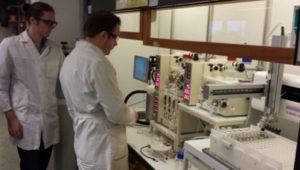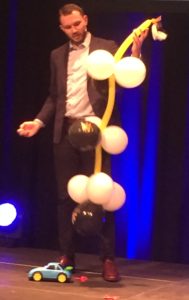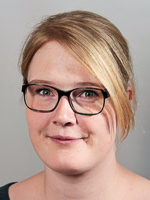Sikresiden – new website with safety and security information

Sikresiden is a mobile-adapted website that provides information about safety and security and helps with what to do in an emergency. https://www.sikresiden.no/en

Sikresiden is a mobile-adapted website that provides information about safety and security and helps with what to do in an emergency. https://www.sikresiden.no/en
Programmet OMNIC er nå klargjort av IT-avd for installasjon på klientdriftede maskiner, og skal snart finnes på datalabene i 1. etg.
Sjekk Software Center og fyr løs.
Vibrerende helsing Egil
Early this year, the department got new instrumentation for flow chemistry. In the lunch seminar this week, Audun will give an introduction to the new technology, in his lecture over the self-chosen topic Enabling technologies: Flow Chemistry.

In more detail: The common laboratory glassware has in decades been the go-to tool for chemists, but it has restricted the way we conduct chemistry. New emerging technologies give the chemist improved control over reaction parameters. Flow chemistry enables new discoveries in multiple branches of chemistry. The basic concepts of flow chemistry and its advantages are presented. Resent developments in the field are highlighted
4D coordinates: Thursday Oct 5 at 12.15, at Tripletten (3069).
All UiB employees are invited to participate in Digital Day in Grieghallen today, October 4th. There, UiB colleagues will present ongoing digitalization projects, tools and methods, and future digital solutions. 
The program consists of:
Many will know that the Kavli prizes are very prestigious awards for the topmost research achievements in nanoscience, astrophysics and neural science, respectively. These prizes are funded and promoted by the Kavli Foundation, and the Foundation is also promoting science and scientific achievements in many other ways.  One example is the Kavli Prize for Nanoscience Symposium – Atomic Force Microscopy: Yesterday, Today and Tomorrow. Co-organized by Det Norske Videnskaps-Akademi and IBM Zürich, 30 Norwegian PhD-students were invited to Zürich to take part in this event, and also to meet and discuss with Nobel prize laureate Gerd Binnig and Kavli prize laureate Christoph Gerber, and other distinguished scientists. From the chemistry department, Malgorzata, Anders and Christian had the good fortune to participate, shown in the picture at the door step of IBM ThinkLab i Rüschlikon!
One example is the Kavli Prize for Nanoscience Symposium – Atomic Force Microscopy: Yesterday, Today and Tomorrow. Co-organized by Det Norske Videnskaps-Akademi and IBM Zürich, 30 Norwegian PhD-students were invited to Zürich to take part in this event, and also to meet and discuss with Nobel prize laureate Gerd Binnig and Kavli prize laureate Christoph Gerber, and other distinguished scientists. From the chemistry department, Malgorzata, Anders and Christian had the good fortune to participate, shown in the picture at the door step of IBM ThinkLab i Rüschlikon!
Despite today being the first Tuesday of the month, we will not enjoy the company of our local TT(Technology Transfer)-officer Elisabeth Silden, due to heavy load in connection to the imminent FORNY2020 deadline (Oct 11).
Last Thursday, the regional Researcher’s Grand Prix competition was held at Campus Kronstad, with Sondre (re)presenting chemistry. Sondre was the last contestant to take the floor in the initial round and he delivered a brilliant and highly visual presentation of his PhD project – how to get from algae lipids to α-olefins. It was particularly impressive to see the ease with which he dehydrogenated an alkane to introduce the double-bond functionality — with the precision of a needle point! The crowd was even more impressed than the jury and voted Sondre to a top-three position! Fellow students and friends from the Chemistry department made a loud and suitably biased supporter crowd — great! Who will rise to the challenge and continue the great tradition set by Kjersti (last year) and Sondre?
Sondre was the last contestant to take the floor in the initial round and he delivered a brilliant and highly visual presentation of his PhD project – how to get from algae lipids to α-olefins. It was particularly impressive to see the ease with which he dehydrogenated an alkane to introduce the double-bond functionality — with the precision of a needle point! The crowd was even more impressed than the jury and voted Sondre to a top-three position! Fellow students and friends from the Chemistry department made a loud and suitably biased supporter crowd — great! Who will rise to the challenge and continue the great tradition set by Kjersti (last year) and Sondre?
Do not miss the opportunity to hear Dr. Ralf Kellmann (Dept. of Biology & Hormonlaboratoriet HelseBergen) tell about their effort to use of synthetic biology to produce neosaxitoxin. Neosaxitoxin is one of the paralytic shellfish toxins (PSTs), which are a group of neurotoxic alkaloids produced by algal blooms, i.e. marine dinoflagellates (red tides) and freshwater filamentous cyanobacteria. PSTs reversibly block voltage-gated sodium channels, and recent clinical trials on humans have indicated a positive safety profile for neosaxitoxin as a long-acting local anesthetic. The major challenge with neosaxitoxin and its relatives is the lack of a large-scale production process. We are employing synthetic biology to develop such a large-scale production process for neosaxitoxin, which we envision will be capable of covering the future world-market demand for neosaxitoxin.
Synthetic biology can be defined as: » the design and construction of novel biological pathways, organisms or devices, or the redesign of existing natural biological systems» (UK Royal Society). It is one of the currently fastest growing research fields, enabled by new technologies, such as the chemically synthesis of long (> 100 kb) DNA, and efficient combinatorial cloning techniques. Synthetic biology can be used as a research tool to uncover and characterise novel biochemical pathways, as well as to develop processes for the industrial production NPs and NP-derived derived drugs.
When and where: Thursday Sept 28 at 12.15 in Tripletten.
 To help the victims of the two recent earthquakes that have devastated Mexico, Ivan and other members of the Mexican community in Bergen will be throwing a fund raiser tomorrow Saturday 23, at the restaurant Amarone in Østre Skostredet 12, from 2 to 6 pm. They will be selling food and organizing other family activities and all earnings will be donated to the Mexican Red Cross. More information on the Facebook page of the event.
To help the victims of the two recent earthquakes that have devastated Mexico, Ivan and other members of the Mexican community in Bergen will be throwing a fund raiser tomorrow Saturday 23, at the restaurant Amarone in Østre Skostredet 12, from 2 to 6 pm. They will be selling food and organizing other family activities and all earnings will be donated to the Mexican Red Cross. More information on the Facebook page of the event.
 MSc. Franziska Ihlefeldt is a Phd student from Prof. Mats Tilset’s group (UiO) working in the GreenCAT project “Design of Green Catalysts for the Conversion of Renewable Resources into Polymers”, led by Erwan Le Roux and funded by NFR. Her project is focusing on the development of N-heterocyclic carbenes of group 8 as catalysts for the copolymerization of epoxides with CO2 . Franziska spent some time in Bergen last fall, and this time around she will have an extended stay at our department, lasting until the end of January next year. Good to have you back!
MSc. Franziska Ihlefeldt is a Phd student from Prof. Mats Tilset’s group (UiO) working in the GreenCAT project “Design of Green Catalysts for the Conversion of Renewable Resources into Polymers”, led by Erwan Le Roux and funded by NFR. Her project is focusing on the development of N-heterocyclic carbenes of group 8 as catalysts for the copolymerization of epoxides with CO2 . Franziska spent some time in Bergen last fall, and this time around she will have an extended stay at our department, lasting until the end of January next year. Good to have you back!